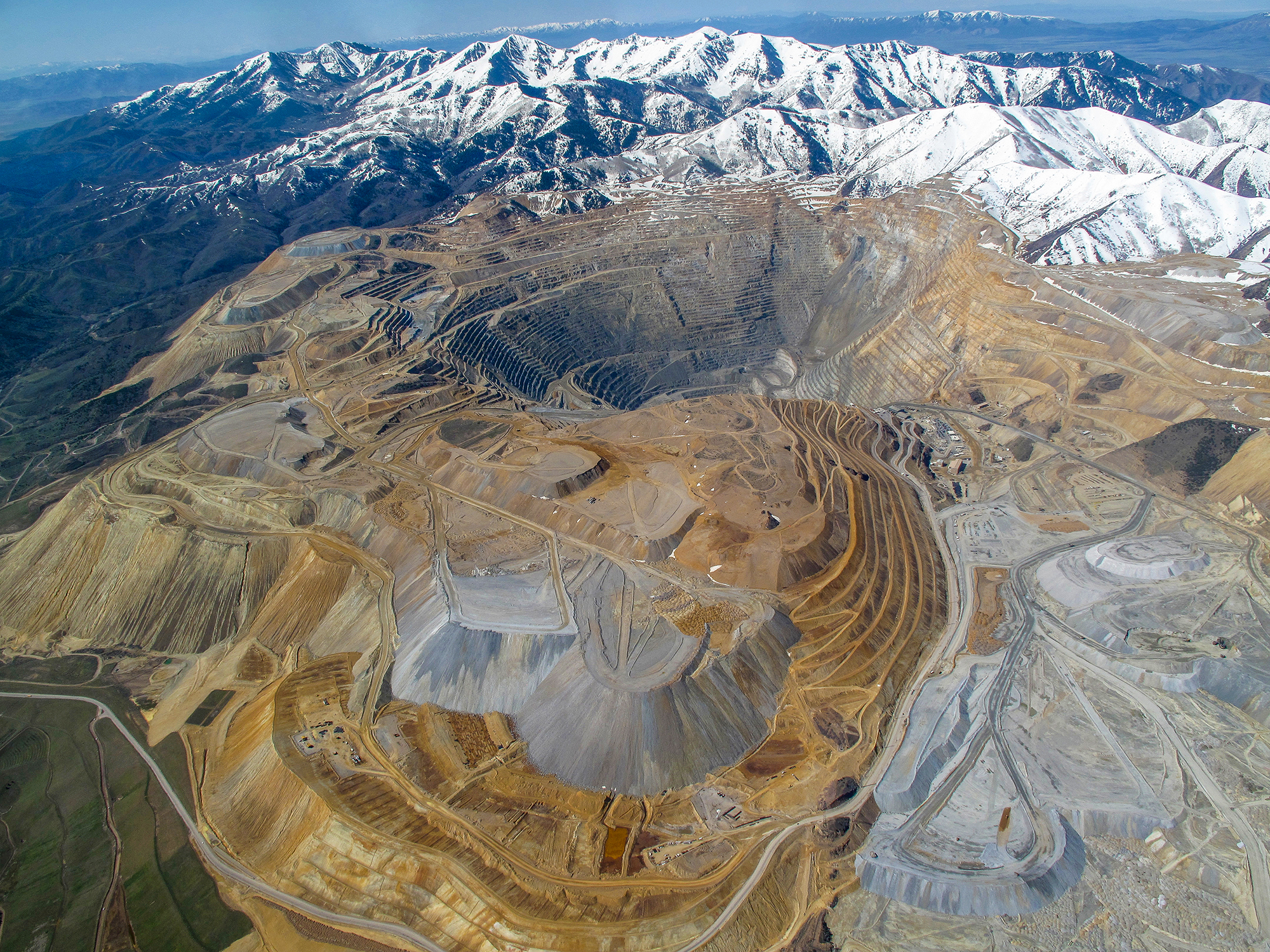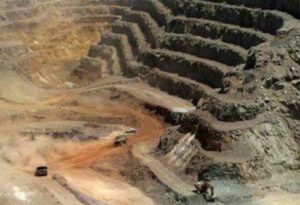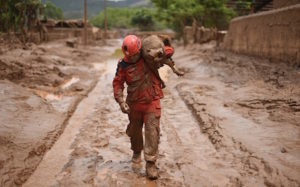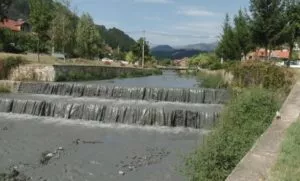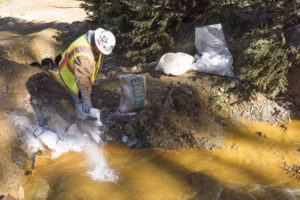Modern Mining: Permanent Landscape Damage
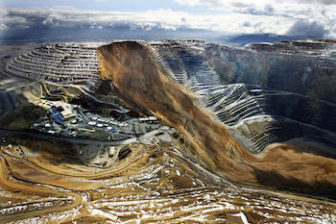
Massive open pit mines are the most common type of industrial metal mine. Rio Tinto’s Bingham Canyon mine southwest of Salt Lake City turned a mountain into a hole almost a kilometer deep and 4 kilometers wide. Modern mines generate huge amounts of waste. For example, the average gold ring generates more than 20 tons of waste.
The Nation’s Top Polluter
It’s not a matter of if a mine will pollute, but when, and for how long. Earthworks’ research of operating U.S. copper mines (accounting for 89% of U.S. copper production) found that 100% had pipeline spills, 92% failed to control mine wastewater and 28% had tailings impoundment failures—polluting drinking water, destroying fish and wildlife habitat, harming agricultural land and threatening public health.
According to the U.S. Environmental Protection Agency’s Toxics Release Inventory, metal mining is the nation’s #1 toxic polluter. Mine waste contains toxic substances like arsenic, mercury, and cadmium that are harmful to public health and fish and wildlife when released into the environment.
Forever polluted water
Mining exposes sulfides in rock which react with water and air to form sulfuric acid. Once the process starts it’s impossible to stop until the acid generating material is depleted, which can take thousands of years. Some Roman mines in Spain still drain acid. The acid drainage can only be treated. The EPA estimates 40% of the headwaters of western watersheds have been polluted by mining, and acid mine drainage is a main reason why.
Globally, mining also dumps mining waste directly into lakes, rivers and oceans: over 220 million tonnes each year.
Mine Tailings Dam Failures
Mine waste, known as tailings, is often impounded behind enormous earthen dams. These tailings have to remain onsite after the mine closes—and the dams can fail catastrophically, releasing vast amounts of mine waste downstream. A tragic dam collapse in 2019 killed 270 people and destroyed the town of Brumadinho, Brazil. The disaster followed tailings dam failures at the Mount Polley mine in Canada and the Samarco mine in Brazil, among others.
And the problem is getting worse. Half of serious tailings dam failures in the last 70 years occurred between 1990 and 2009. Nineteen catastrophic failures are predicted globally from 2018 and 2027. Across the world, communities in the shadow of large tailings dams live in a state of perpetual fear. These communities often are Black, brown, Indigenous, poor, and otherwise already marginalized. They have little access to any political power that could keep them safe, and when the dams fail, they have no way to demand adequate reparations.
In 2020, an international group of 142 scientists, community groups and NGOs from 24 countries published Safety First: Guidelines for Responsible Mine Tailings Management. The guidelines aim to protect communities, workers and the environment from the risks posed by thousands of mine waste storage facilities, which are failing more frequently and with more severe outcomes.
Communities destroyed

Rosia Montana open pit gold mine.
Because few countries have codified the principles of free, prior and informed consent (FPIC), much of this gold was mined coercively. For example, mining operations sometimes forcibly resettle entire communities.
Mining has also been tied to violence and human rights abuses, such as funding the decades old conflict in the Congo and human rights abuses surrounding the Conga mine in Peru.
Towards better mining
Although mining is inherently destructive, it can be less environmentally damaging and more respectful of communities.
1872 Mining Law reform
In the United States metal mining on hundreds of millions of acres of publicly owned lands is governed by a 19th century law that:
- contains no environmental provisions,
- has given away more than $300 billion in publicly owned minerals, and
- permits mines even when the land would be better used for another purpose.
Almost 150 years later, we know how to fix the problem.
Regulatory Reform
There are a number of actions ready and waiting for the Biden-Harris administration to act on that do not require Congressional approval:
- Comprehensive Environmental Response, Compensation, and Liability Act (CERCLA) 108b. Although the EPA has the statutory authority under Section 108b of CERCLA to require mining companies to provide financial assurance to demonstrate that adequate funds are in place to complete mine cleanup, more than 30 years after the statute was enacted the EPA has failed to develop rules to implement its authority.
- Clean Water Act ‘fill material’ definition. A 2002 revision of regulations expanded the definition of “fill material” under Section 404 of the Clean Water Act to include mine waste. Section 404 was intended to regulate the placement of rock, soil, clay, sand and other materials normally used in construction related activities, not mining waste.
Community Initiatives
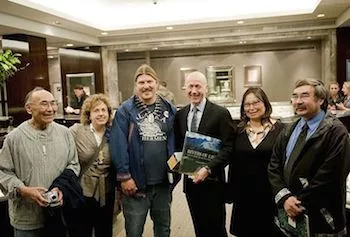
Organized community opposition can be one of the greatest tools in protecting communities and the environment from mining’s negative impacts. In Alaska’s Bristol Bay watershed, for example, Native Alaskans, commercial fishermen, jewelers, and investors are fighting to protect the world’s largest wild salmon fishery from the proposed Pebble Mine.
Making Clean Energy Clean, Just & Equitable
We are in the midst of an urgent transition to renewable energy—a transition necessary to avert the worst of the climate catastrophe.
Yet renewable energy and electric vehicle production require cobalt, nickel, lithium and other key minerals that are dug out of the ground. Unfortunately, mining is a dirty business with a long track record of human rights abuses and environmental destruction. By demanding responsibly-sourced minerals, clean tech companies can accelerate our renewable energy transition and push the mining industry to clean up its act. In order to ensure that our clean energy economy is truly clean—as well as just and sustainable—we must develop a shared commitment to responsible mineral sourcing, recycling, substitution and materials efficiency, coupled with a reduction in overall energy and mineral demand. Mining should be the last place we look for metals sourcing, not the first.
Initiative for Responsible Mining Assurance
IRMA is the world’s most rigorous standard for more responsible mining. It has developed voluntary, independently certified mining standards that will raise the social and environmental standards of mine sites around the world. The participation of tech, EV, and other companies in IRMA is essential, and many major corporations, including BMW, Daimler-Benz, Ford Motor Company, Microsoft and Tiffany & Co., have joined the initiative.
For More Information
- 1872 Mining Law
- 1872 Mining Law – Reform requirements
- Abandoned Mines
- Acid Mine Drainage
- Conflict Minerals
- Copper Sulfide Mining
- Cyanide
- Free, Prior and Informed Consent (FPIC)
- In-situ Leach Uranium Mining
- Mercury Air Emissions from Gold Mines
- Making Clean Energy Clean, Just & Equitable
- Tailings
- Toxics Release Inventory – What is it?

